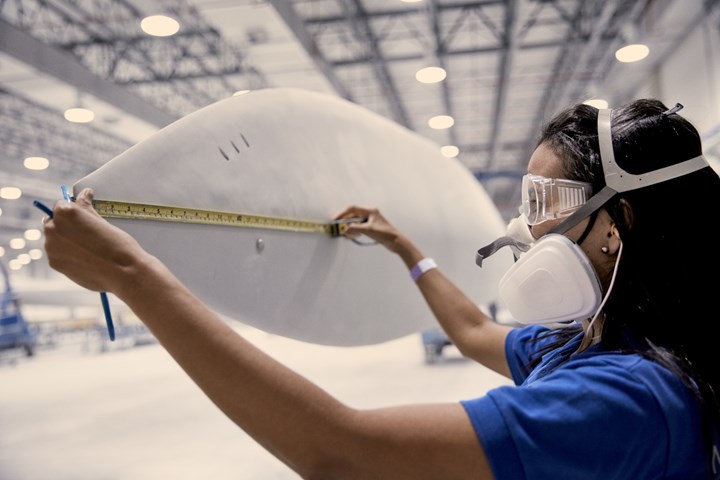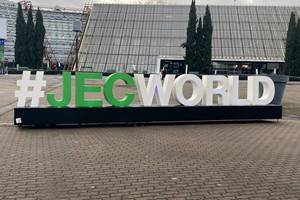LM Wind Power reports it will produce zero waste blades by 2030
Blade manufacturing waste prevention and recycling becomes the GE Renewable Energy business’ primary focus as it seeks to reduce its carbon footprint.

Photo Credit: LM Wind Power
On Nov. 23, LM Wind Power (Kolding, Denmark), a GE Renewable Energy business, announced its pledge to produce zero waste blades by 2030 in order to reduce the carbon footprint of the company’s products. The commitment represents a step forward in the company’s sustainability journey after becoming what is says was the first carbon-neutral business in the wind industry back in 2018.
LM Wind Power will play a central role in supporting its customers to develop fully circular wind turbines that generate less waste during their production. In practice, LM Wind Power’s vision of zero waste blades means the company aims to send no manufacturing materials and packaging to landfill and incineration without energy recovery by 2030.
Waste from manufacturing represents one of the biggest challenges faced by many industries as they seek to reduce their carbon footprint. Nearly one third of its operational carbon footprint comes from waste disposal. Moreover, in the wind industry, around 20-25% of the materials purchased by wind turbine blade manufacturers do not go into the final product, and research indicates that blade manufacturing waste volumes are expected to be larger than decommissioned blade volumes during the coming decade.
“We have a track record of working with our partners to address our most pressing challenges. Our technology has played a crucial role in making wind power one of the most competitive sources of electricity,” states Olivier Fontan, CEO of LM Wind Power. “Now the focus has evolved from making wind power not only competitive, but also making the industry sustainable. It is not one or the other but both. We are determined to work with our partners to reduce the carbon footprint of wind turbines; together we can be the example of how an industry transforms its value chain to support the green transition and the critical move to a circular economy. Zero waste blades are our contribution to this industry mission.”
For wind turbine and blade manufacturers alike, LM Wind Power says, the key to reducing the product carbon footprint lies in the supply chain. In the blade life cycle, around 75% of CO2 emissions occur in the supply chain.
“This is a call to action for suppliers to the wind industry: Join us in designing out waste from our value chain,” says Hanif Mashal, LM Wind Power vice president, engineering and technology. “Engagement with our supply chain on waste prevention will increase over the coming years; in partnerships we will also explore how we can ultimately deliver waste back to suppliers, for recycling into new materials that will be supplied to the wind industry or other sectors.”
While blade manufacturing waste prevention and recycling will be a major focus for the company, LM Wind Power is also working with partners to establish sustainable, large-scale solutions to recycle decommissioned blades through the DecomBlades project. The wind company is also engaged in the development of next-generation blades that can be more easily recycled through the (see more “Arkema's partnership with ZEBRA project commits to circular economy”).
Related Content
JEC World 2024 highlights: Glass fiber recycling, biocomposites and more
CW technical editor Hannah Mason discusses trends seen at this year’s JEC World trade show, including sustainability-focused technologies and commitments, the Paris Olympics amongst other topics.
Read MoreBladder-assisted compression molding derivative produces complex, autoclave-quality automotive parts
HP Composites’ AirPower technology enables high-rate CFRP roof production with 50% energy savings for the Maserati MC20.
Read MorePartners recycle A350 composite production waste into adjustable-length rods for MFFD
Herone, Spiral RTC, Teijin Carbon Europe and Collins Aerospace Almere recycle A350 thermoplastic composite clips/cleats waste into rods for the all-thermoplastic composite Multifunctional Fuselage Demonstrator’s crown.
Read MoreASCEND program completion: Transforming the U.K.'s high-rate composites manufacturing capability
GKN Aerospace, McLaren Automotive and U.K. partners chart the final chapter of the 4-year, £39.6 million ASCEND program, which accomplished significant progress in high-rate production, Industry 4.0 and sustainable composites manufacturing.
Read MoreRead Next
Cutting 100 pounds, certification time for the X-59 nose cone
Swift Engineering used HyperX software to remove 100 pounds from 38-foot graphite/epoxy cored nose cone for X-59 supersonic aircraft.
Read MoreCeramic matrix composites: Faster, cheaper, higher temperature
New players proliferate, increasing CMC materials and manufacturing capacity, novel processes and automation to meet demand for higher part volumes and performance.
Read MoreUltrasonic welding for in-space manufacturing of CFRTP
Agile Ultrasonics and NASA trial robotic-compatible carbon fiber-reinforced thermoplastic ultrasonic welding technology for space structures.
Read More












